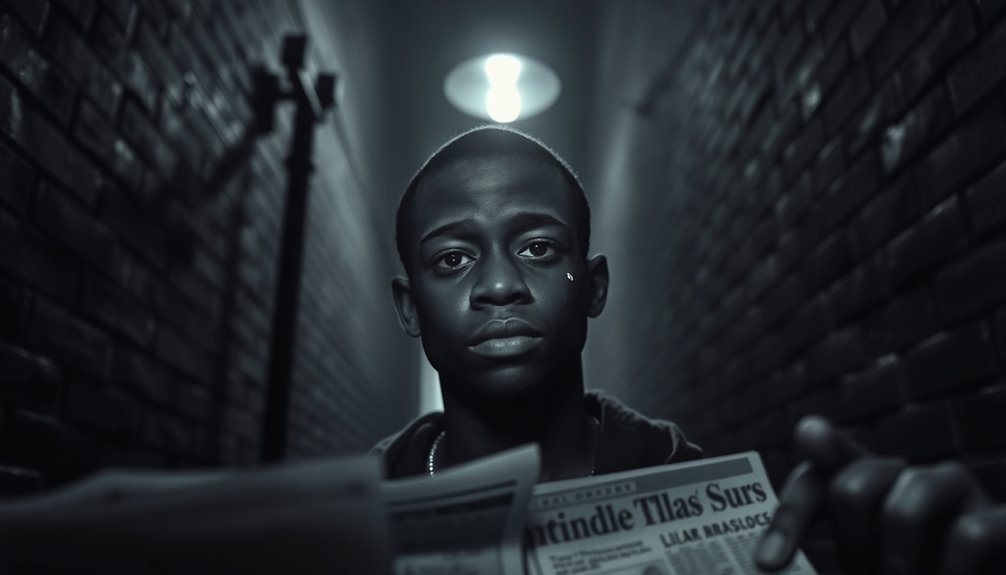In 'Native Son,' you follow Bigger Thomas, a Black man traversing 1930s Chicago, where systemic racism and poverty shape his life. Initially hopeful about his job with the Dalton family, he quickly feels their patronizing attitudes trapping him in alienation. An accidental death thrusts him into a nightmarish trial, exposing the racial biases of the justice system. Throughout the story, Bigger grapples with oppression, identity, and the struggle for autonomy. His journey transforms despair into a flicker of hope as he contemplates rebellion against societal norms. To understand more about Bigger's complex world, you'll uncover deeper themes and reflections.
Overview of the Novel
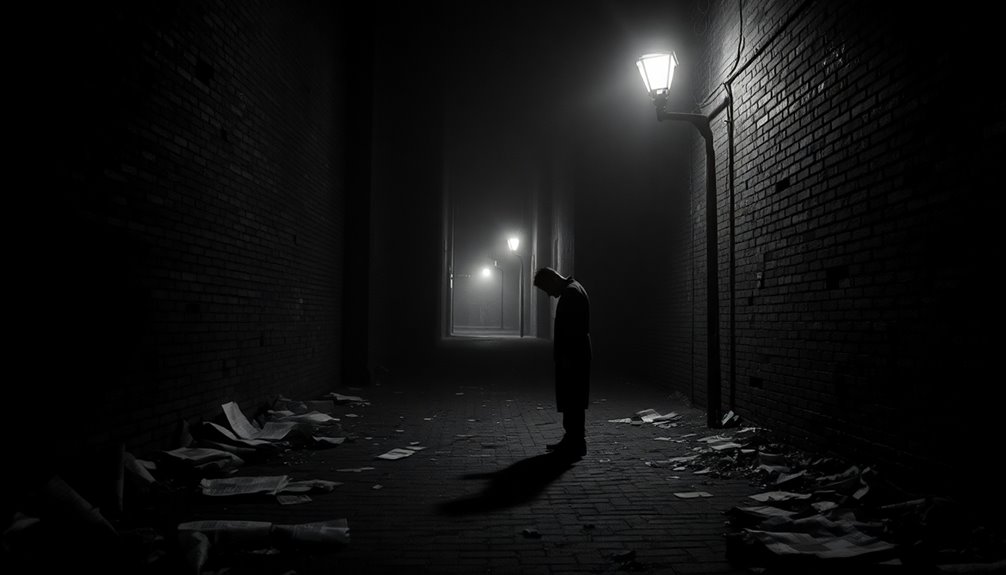
In Richard Wright's groundbreaking novel "Native Son," you immerse yourself in the harrowing world of Bigger Thomas, a young Black man grappling with systemic racism and poverty in 1930s Chicago. This powerful novel is structured into three parts—"Fear," "Flight," and "Fate"—each revealing different facets of Bigger's life and the oppressive societal conditions he faces.
Initially, you witness Bigger's excitement as he secures a job as a chauffeur for the wealthy Dalton family, a pivotal moment that seems to promise a change in his fortunes. However, this hope quickly dissipates as you see how racial dynamics transform his experience into one of alienation and entrapment. Coates' reflections on the impact of systemic oppression highlight the struggles faced by individuals like Bigger in their quest for identity and agency. The novel serves as a stark reminder of how collective action can be a response to such systemic challenges.
Throughout the novel, Wright intricately explores themes of oppression, identity, and the struggle for self-definition.
As the narrative unfolds, you're drawn into the tragic culmination of Bigger's life when he's put on trial for the murder of Mary Dalton. This moment starkly reveals the deep-rooted injustices and racial prejudices permeating the American legal system. The novel serves as a critique of racial inequalities contributing to the poverty cycle.
Wright's portrayal of Bigger's journey is both compelling and unsettling, offering a profound commentary on the human condition in the face of despair.
Bigger's Struggles and Alienation
Amid the oppressive backdrop of 1930s Chicago, Bigger Thomas grapples with profound struggles that stem from his alienation in a racially biased society.
In Bigger's life, his initial excitement about working as a chauffeur for the wealthy Dalton family quickly turns to discomfort. Their patronizing attitudes reinforce his status as an outsider, further deepening his sense of isolation. The societal expectations placed on him as a Black man weigh heavily, culminating in a tragic incident: the accidental death of Mary Dalton after a night of drinking. This event starkly illustrates how racial dynamics impact Bigger's psyche, as he fears being wrongfully accused of murdering a white woman. His vulnerability and isolation grow as he realizes that his identity is shaped by oppressive societal forces, highlighting the struggle for personal equilibrium in a world rife with injustice. In this context, Bigger's experiences resonate with themes of resilience amid adversity, reflecting the challenges faced by those under tyrannical rule.
Bigger's life becomes a reflection of systemic barriers that limit his opportunity to define himself and his future. These struggles serve as a powerful commentary on the psychological effects of systemic racism.
As you explore his journey, you witness how despair and helplessness take root, showcasing the debilitating impact of his alienation in a world that dehumanizes him at every turn. Additionally, the historical context of oppressive systems echoes the themes found in works like Guns, Germs, and Steel, which investigate how geography and demography shape societal success and inequality.
The Role of Employment
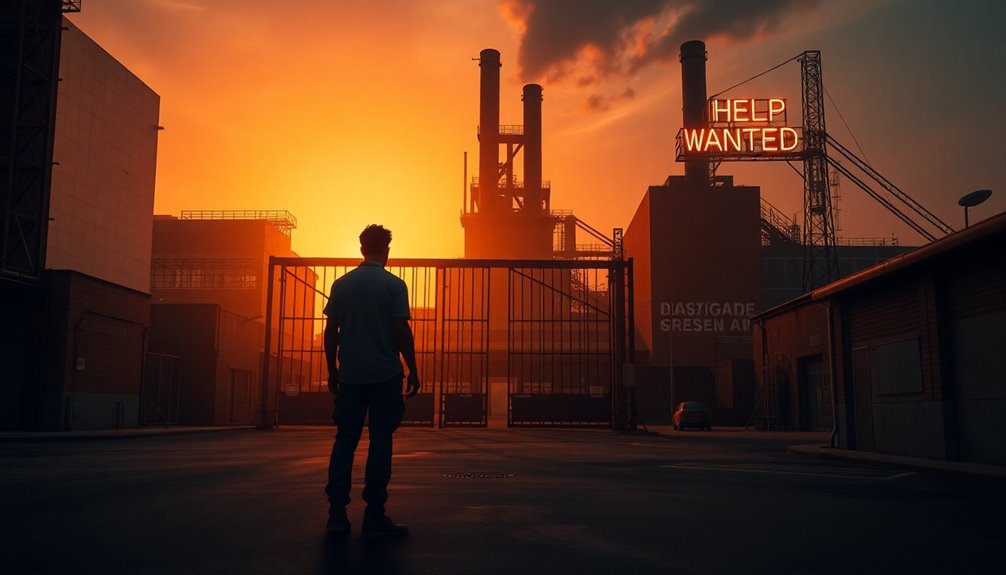
In "Native Son," Bigger's job as a chauffeur for the Dalton family initially sparks hope for a better future but quickly reveals the deep alienation he feels within a racially charged society. You see how his employment becomes a complicated reflection of his identity, as he navigates the expectations placed on him by both his employers and the broader world. Ultimately, this job underscores the harsh realities of systemic racism that limit opportunities for Black individuals, shaping Bigger's tragic journey. Moreover, the story exemplifies how systemic discrimination fuels racial inequalities, ultimately trapping individuals in cycles of despair and hopelessness. The experiences of characters like Bigger resonate with hidden contributions of marginalized voices, illustrating the broader implications of societal inequities. Furthermore, the systemic barriers faced by Bigger parallel the struggles of unsung heroes who have tirelessly fought against oppression, highlighting the pervasive influence of inequality throughout history.
Bigger's Job Experience
Often, Bigger Thomas's job as a chauffeur for the Dalton family serves as a pivotal moment in his life, igniting a mix of hope and despair. Initially, this role offers you a glimpse of a better future, yet it quickly reveals the harsh realities of systemic racism and social oppression. The well-intentioned, yet misguided, attempts at racial equality by the Daltons only highlight their privilege and your discomfort.
This job experience unfolds in critical ways:
- You feel the stark contrast between your impoverished life and the Daltons' wealth.
- Your excitement morphs into inadequacy and resentment as you navigate these differences.
- The night of Mary Dalton's tragic death symbolically collapses your aspirations.
- Fear of societal retribution looms over every interaction.
- Ultimately, the job embodies the limitations imposed by racial dynamics.
Bigger's employment is more than a means to earn; it becomes a reflection of the barriers that define your existence. Instead of upward mobility, it serves as a reminder of the societal expectations that stifle your potential, illustrating how deeply ingrained systemic racism shapes your reality.
Alienation From Society
Employment becomes a double-edged sword for Bigger Thomas, offering a fleeting sense of hope while simultaneously deepening his alienation from society. When he first lands the job as a chauffeur for the Daltons, you can sense his excitement. He sees this as a chance to escape the poverty that constrains him.
However, as you observe Bigger's interactions with the Daltons, it becomes clear that their well-meaning yet patronizing attitudes intensify his discomfort. Their ignorance about his struggles highlights the racism and oppression embedded in their lives, pushing him further away from genuine connection.
Bigger's internal conflict grows as he grapples with societal expectations placed upon him as a Black man. When he accidentally kills Mary Dalton, the weight of his alienation from society crushes him.
This moment reveals the terrifying reality of living under the threat of violence and injustice, where your existence feels overshadowed by systemic racism. Bigger's employment, rather than liberating him, becomes a constant reminder of the oppressive forces he can't escape.
It's a tragic illustration of how, for many, work can simultaneously offer opportunity and deepen feelings of isolation within a prejudiced world.
Employment and Identity
Securing a job as a chauffeur for the Daltons initially lifts Bigger Thomas out of his bleak reality, but it quickly becomes a double-edged sword that complicates his sense of self. While this employment offers a brief glimpse of hope, it also exposes Bigger to the patronizing attitudes of the Daltons, which heighten his feelings of alienation and confusion about his identity.
- The Daltons' misguided attempts at racial equality serve as a constant reminder of societal expectations.
- Bigger struggles internally with the implications of working for a white family in a racially charged environment.
- His aspirations clash with systemic racism, turning a job into a source of anxiety.
- The accidental killing of Mary Dalton shifts his employment from a potential lifeline to a catalyst for his downfall.
- Ultimately, the juxtaposition of his dreams against harsh realities reveals how employment can trap marginalized individuals rather than liberate them.
Bigger's journey highlights how employment isn't just about financial stability; it's intricately tied to identity, intensifying his internal struggle in a world that refuses to see him as anything more than his race.
The Trial and Its Implications
In examining Bigger Thomas's trial, you see how systemic injustices shape the legal landscape for Black defendants. The racial dynamics at play not only influence the prosecution's tactics but also expose the weaknesses in Bigger's defense strategy. This trial isn't just about one man; it highlights the broader implications of racism in the justice system. It also serves as a reflection of the consequences of manipulation seen in societal structures that perpetuate inequality. Wright's portrayal of Bigger's plight emphasizes the enduring legacy of social justice activism as a necessary response to such injustices, much like the resistance against oppression depicted in 'Alone in Berlin.'
Systemic Injustice in Trials
While the trial of Bigger Thomas unfolds, it starkly illustrates how systemic injustice permeates the American legal system, particularly for marginalized individuals. You see how racial biases heavily influence the proceedings, making it clear that the system is rigged against people like Bigger. His defense, led by an inexperienced white lawyer, further emphasizes the challenges defendants of color face.
Key elements of systemic injustice in this trial include:
- The prosecutor's exploitation of racial tensions, portraying Bigger as a dangerous criminal.
- The manipulation of public perception that reinforces harmful stereotypes about Black men.
- The defense's struggle to adequately represent Bigger's circumstances amid overwhelming bias.
- The inherent inequalities that lead to Bigger's guilty verdict and death sentence.
- The broader commentary on how systemic racism affects the outcome of cases involving marginalized individuals.
Ultimately, Bigger's trial isn't just a personal tragedy; it's a reflection of a flawed judicial system that fails to deliver justice.
You can't help but recognize the urgent need for reform, as the injustices faced by Bigger resonate far beyond his individual case.
Racial Dynamics Explored
The trial of Bigger Thomas starkly reveals the racial dynamics that underpin the American justice system, illustrating how deeply entrenched biases shape not only the proceedings but also public perception.
In this harrowing courtroom drama, the prosecution exploits systemic racism to depict Bigger as a menacing figure, leveraging the jury's fears rather than the facts of the case. The prosecutor's emphasis on Bigger's race serves to manipulate the mainly white jury, showcasing the profound racial prejudices that permeate the trial.
Despite the efforts of Bigger's well-meaning white lawyer, who tries to highlight the societal conditions leading to Bigger's actions, the defense's approach falls short. The lawyer's inexperience in addressing racial issues fails to dismantle the prejudiced narrative that surrounds Bigger.
As the trial unfolds, it becomes evident that the verdict speaks not just to Bigger's guilt or innocence, but to the broader implications of racial injustice in society. The jury's decision ultimately reflects a system that perpetuates cycles of oppression, denying marginalized individuals a fair chance at justice.
This trial acts as a chilling reminder of how racial dynamics can dictate lives and outcomes in profoundly unjust ways.
Bigger's Defense Strategy Failures
Bigger's defense strategy fails miserably due to the lack of understanding and experience from his white lawyer, who struggles to address the complexities of systemic racism. This inadequacy is evident throughout the trial, where Bigger's life and circumstances are overshadowed by racial prejudices. The prosecution capitalizes on these biases, portraying Bigger as a dangerous criminal, which sways public perception against him.
Key points that illustrate the failures of Bigger's defense include:
- The lawyer's inability to articulate the systemic issues affecting Bigger's life.
- The exploitation of racial tensions by the prosecution to paint a negative image of Bigger.
- The jury's bias, which prioritizes race over the specifics of Bigger's actions.
- The failure to effectively challenge societal stereotypes impacting the trial.
- The broader implications of a flawed justice system that marginalizes Black defendants.
As a result, Bigger is found guilty and faces the death penalty, reflecting the grim reality of systemic inequalities.
This trial not only highlights the shortcomings of Bigger's defense but also exposes the deep-rooted flaws in the American justice system, ultimately denying him any semblance of justice.
Max's Influence on Bigger
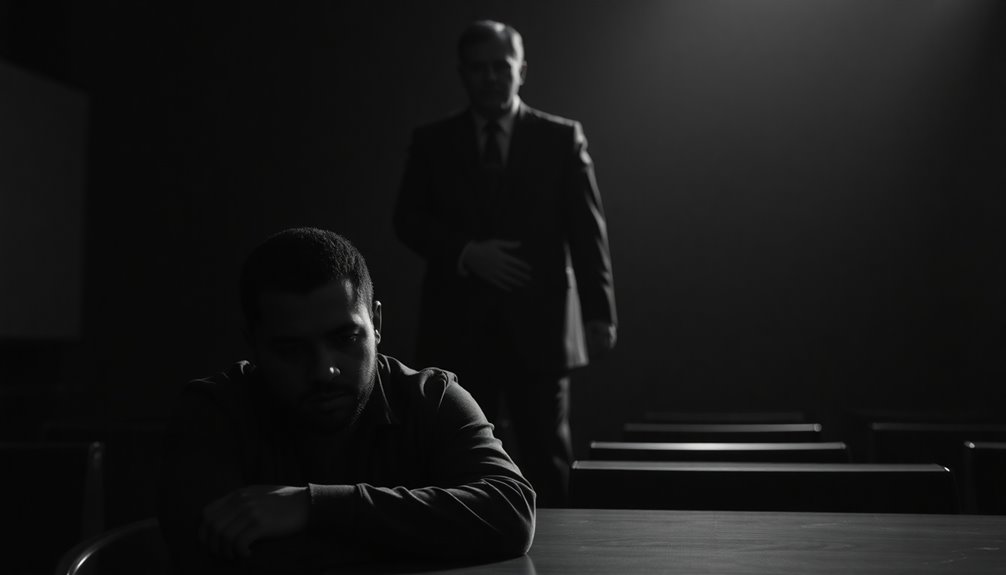
Max plays an important role in shaping Bigger's perspective on his life and circumstances. As a communist lawyer, he enters Bigger's life in prison, challenging him to reconsider his beliefs about crime and identity.
Through their conversations, Max's influence on Bigger becomes clear. He argues that Bigger's actions stem from the systemic injustices he faced as a young Black man in the South Side, rather than any personal failing. This revelation illustrates the devastating impact of societal oppression and the role White people play in perpetuating it. The ongoing debates about the legalization of recreational drugs reveal how systemic issues can lead to further marginalization and misunderstanding of affected communities.
As Max presents new ideological perspectives, Bigger begins to see that his situation isn't solely about individual choices but rather a collective struggle against the oppressive systems that still exist. This understanding allows him to recognize the broader implications of shame in queer life, which Baldwin poignantly explores in his work.
Wright is a powerful voice in Native Son, telling the story of Bigger Thomas, who initially feels isolated and hopeless. However, as he embraces Max's views, he finds a sense of purpose and a desire for resistance. This transformation is significant in Bigger's life, moving him away from despair and towards a new understanding of his identity and the possibility of change for himself and his mother and siblings. Additionally, this narrative reflects the importance of a growth mindset in overcoming adversity and achieving personal development.
Themes of Systemic Racism
Systemic racism pervades every aspect of Bigger Thomas's life, shaping his experiences and choices in profound ways. In Richard Wright's well-written novel, you see how this pervasive injustice limits Bigger's opportunities and fosters an environment rife with fear and alienation. The societal structures of 1930s Chicago dictate not only his personal interactions but also the tragic trajectory of his life.
- Bigger is confined to a life of despair and hopelessness.
- The Dalton family's patronizing attitudes exacerbate his discomfort and isolation.
- His accidental killing of Mary Dalton highlights the dire consequences of racial dynamics.
- The trial reveals the deep-seated biases within the American justice system.
- Pursuing the American Dream feels impossible under systemic oppression.
Through these themes, Wright critiques the illusion of success for African Americans, exposing how systemic racism curtails their aspirations. Bigger's story serves as a tragic reminder of how societal barriers can obliterate self-definition and agency.
As you engage with the narrative, it becomes clear that these themes resonate deeply, prompting reflection on the ongoing impact of systemic racism today.
Exploration of Hope and Resistance
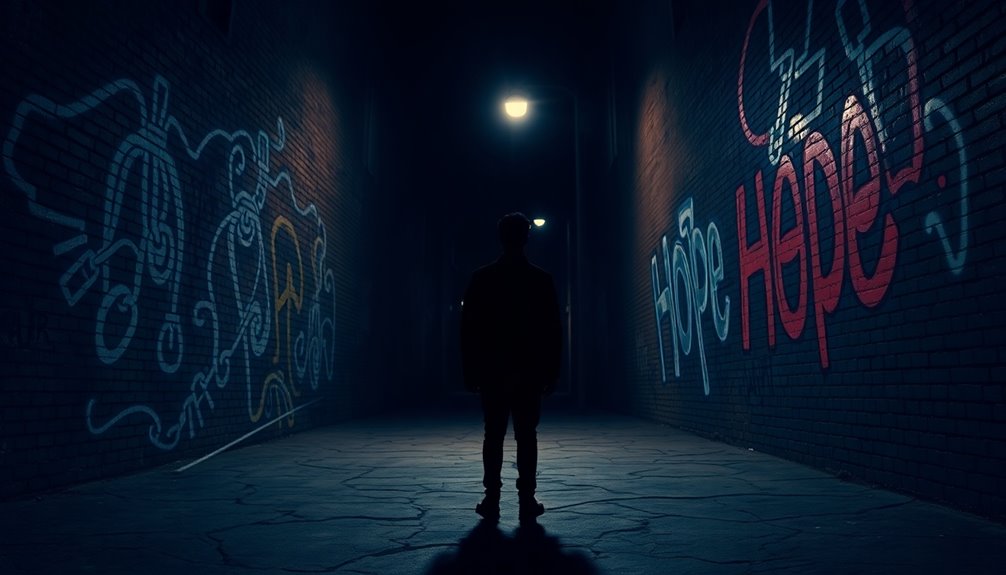
In "Native Son," you see Bigger Thomas undergo a transformative realization that sparks his resistance against the oppressive forces around him.
As he grapples with his circumstances, hope emerges even amidst despair, showcasing his desire for change and justice.
This journey highlights the power of understanding one's oppression as a pathway to empowerment and action.
Bigger's Transformative Realization
Amid the harsh realities of his incarceration, Bigger Thomas undergoes a transformative realization that reshapes his understanding of himself and the world around him. Engaging in dialogue with Max, his communist lawyer, you witness Bigger's resistance gradually melt away as he confronts the oppressive societal conditions that have shaped his life.
This journey leads him to recognize the systemic racism and poverty that drove his actions, igniting a profound internal conflict.
Through this realization, Bigger begins to explore the following ideas:
- The impact of systemic oppression on individual lives
- Acknowledgment of his crime as a byproduct of societal forces
- The importance of self-reflection in understanding one's circumstances
- The potential for collective struggle against injustice
- A newfound sense of hope and purpose in the face of despair
As you read, it becomes clear that Bigger's evolution represents a shift from feeling extremely poor in spirit to embracing responsibility for his actions.
He acknowledges the larger injustices that contributed to his plight, embodying a powerful message of hope and the possibility of resistance against the oppressive structures that have marginalized him.
Resistance Against Oppression
Bigger Thomas's journey through the oppressive landscape of his existence reveals the profound struggle against societal forces that seek to define him. In "Native Son," Wright tells the story of a young Black man grappling with systemic racism that stifles his identity and agency.
Despite the heavy weight of societal expectations and racial prejudice, you see a flicker of resistance emerge as Bigger engages with Max's revolutionary ideas. This moment symbolizes a collective yearning for change, highlighting the power of solidarity in the face of oppression.
Even in the darkest hours, Wright emphasizes that the possibility of resistance exists. Bigger's growing awareness of the systemic injustices around him marks a significant turning point.
You witness his transformation from a passive victim of circumstance to someone contemplating rebellion, showcasing a nuanced understanding of hope amid despair. The conclusion of the novel drives home the message that true liberation stems from recognizing and confronting these systemic inequalities.
It emphasizes resilience and the importance of standing against adversity, reminding you that the fight against oppression isn't just a personal battle but a communal struggle for justice and dignity.
Hope Amid Despair
The journey through "Native Son" reveals that even in the depths of despair, hope can spark transformative change. Bigger Thomas's evolution reflects the potential for cultural resilience, demonstrating that personal growth is possible even amidst systemic oppression. His character, initially trapped by societal expectations, begins to envision a path toward empowerment and justice through his interactions with Max, the communist lawyer.
Key moments highlight this theme of hope amid despair:
- Bigger's internal struggle signifies his awakening consciousness.
- Max introduces revolutionary ideas that inspire Bigger's vision for equality.
- Resistance against societal norms emerges as a form of agency.
- The narrative emphasizes moments of personal revelation.
- The conclusion leaves readers with a sense of possibility for change.
Wright's portrayal suggests that understanding and confronting systemic injustices can lead to meaningful resistance.
As you witness Bigger's transformation, you're reminded that hope isn't just a fleeting feeling; it can be a powerful catalyst for change. The story ultimately underscores that amidst the pervasive darkness of racism, there exists a flicker of hope, urging readers to believe in the possibility of a better future.
Critical Reception and Legacy
"Native Son" has garnered significant attention since its release, often sparking intense discussions about race and systemic oppression in America. Upon its debut in 1940, the novel received a mix of praise and criticism; some readers celebrated its raw portrayal of racial injustice, while others found its bleak outlook troubling. This duality in reception reflects the complexities inherent in addressing such a sensitive topic.
Richard Wright's work has undeniably left a lasting literary influence. It has shaped not only the discourse around race relations but also inspired generations of writers and activists. The novel's inclusion in numerous literary anthologies signifies its significance in academic settings, where it serves as a cornerstone for understanding America's historical context regarding race.
Today, "Native Son" continues to resonate, reminding us of the ongoing struggles against racism and inequality. Its legacy is felt in contemporary literature, where modern authors often engage with the themes Wright explored.
Suggested Readings and Resources

Exploring the themes presented in "Native Son" can be enriched by delving into a variety of complementary texts. These readings provide essential cultural context and deepen your understanding of systemic racism, identity, and resilience. They echo the struggles faced by Bigger Thomas and highlight the broader societal issues addressed in Wright's work.
Here are some suggested readings that enhance your exploration of these themes:
- "Black Boy" by Richard Wright: This autobiographical account reveals the author's early life under systemic racism, paralleling the injustices in "Native Son."
- "The Invisible Man" by Ralph Ellison: This novel explores identity and invisibility in a racially divided society, making it essential for understanding Wright's themes.
- "Native Speaker" by Chang-rae Lee: This contemporary work offers insights into race and identity that resonate with Bigger's experiences.
- "Between the World and Me" by Ta-Nehisi Coates: Coates' reflections on race and oppression echo the hardships depicted in Wright's narrative.
- "The Color Purple" by Alice Walker: This novel emphasizes oppression and resilience, aligning with the struggles found throughout "Native Son."
Engaging with these texts will provide a richer understanding of the issues Wright confronts.
Author's Background and Impact
Richard Wright's profound impact on American literature stems from his powerful exploration of race and identity, which resonates deeply with readers even today. As an influential African American author, Wright confronted the brutal realities faced by Black Americans, especially through his acclaimed novel "Native Son," published in 1940. His upbringing in the Jim Crow South shaped his understanding of systemic racism, fueling his exploration of oppression, identity, and the struggle for self-definition.
Wright employed various literary techniques, including vivid imagery and stark symbolism, to illustrate the complexities of racial dynamics in American society. His works, such as "Black Boy," provide autobiographical insights that further illuminate the societal challenges he faced. Through his narratives, Wright not only depicted the harsh truths of racial injustice but also invited readers to reflect on their own perceptions of race and identity.
Wright's legacy endures as his writings continue to be integral to academic curricula, influencing generations of readers and writers. By engaging with his work, you gain a deeper understanding of the intricate connections between race, history, and culture, making his contributions invaluable to American literature.
Conclusion
In "Native Son," you witness Bigger's fight against oppression, you feel his isolation, and you grapple with the consequences of his actions. Through Max's defense, you recognize the complexities of justice and the struggle for understanding. As you explore hope and resistance, you see the enduring impact of Bigger's story. Ultimately, you're left questioning society's role in shaping identity, urging you to reflect on the cycles of injustice that still resonate today.

